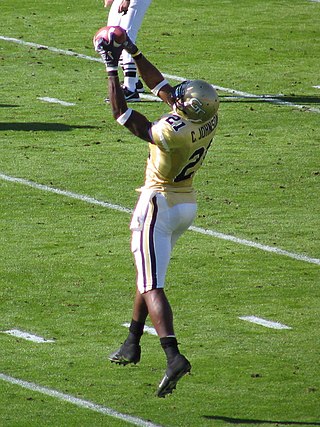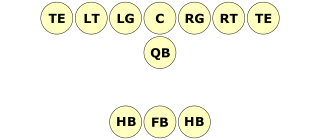
A running back (RB) is a member of the offensive backfield in gridiron football. The primary roles of a running back are to receive handoffs from the quarterback to rush the ball, to line up as a receiver to catch the ball, and block. There are usually one or two running backs on the field for a given play, depending on the offensive formation. A running back may be a halfback, a wingback or a fullback. A running back will sometimes be called a "feature back" if he is the team's starting running back.

A wide receiver (WR), also referred to as a wideout, historically known as a split end (SE) or flanker (FL), is an eligible receiver in gridiron football. A key skill position of the offense, WR gets its name from the player being split out "wide", farthest away from the rest of the offensive formation.
Strategy forms a major part of American football. Both teams plan many aspects of their plays (offense) and response to plays (defense), such as what formations they take, who they put on the field, and the roles and instructions each player are given. Throughout a game, each team adapts to the other's apparent strengths and weaknesses, trying various approaches to outmaneuver or overpower their opponent in order to win the game.On offense your job on the field is to score you can do that by scoring a touchdown by advancing the ball into the end zone either by running the ball or passing it another way to score is by field goal which is worth three points.Your job on defense is to prevent the other team from scoring and from gaining ground this way they get as little points as possible
American football positions have slowly evolved over the history of the sport. From its origins in early rugby football to the modern game, the names and roles of various positions have changed greatly, some positions no longer exist, and others have been created to fill new roles.
A formation in American football refers to the position players line up in before the start of a down. There are both offensive and defensive formations and there are many formations in both categories. Sometimes, formations are referred to as packages.

In sports, a starting lineup is an official list of the set of players who will participate in the event when the game begins. The players in the starting lineup are commonly referred to as starters, whereas the others are substitutes or bench players.

The I formation is one of the most common offensive formations in American football. The I formation draws its name from the vertical alignment of quarterback, fullback, and running back, particularly when contrasted with the same players' alignments in the T formation.
The halfback option play is an unorthodox play in American and Canadian football. It resembles a normal running play, but the running back has the option to throw a pass to another eligible receiver before crossing the line of scrimmage.

Single set back is an offensive base formation in American football which requires only one running back lined up about five yards behind the quarterback. There are many variations on single back formations including two tight ends and two wide receivers, one tight end/three wide receivers, etc. The running back can line up directly behind the quarterback or offset either the weak side or the strong side.

In American football, a T formation is a formation used by the offensive team in which three running backs line up in a row about five yards behind the quarterback, forming the shape of a "T".

A halfback (HB) is an offensive position in American football, whose duties involve lining up in the offensive backfield and carrying the ball on most rushing plays, i.e. a running back. When the principal ball carrier lines up deep in the backfield, and especially when that player is placed behind another player, as in the I formation, that player is instead referred to as a tailback.

In American football, the specific role that a player takes on the field is referred to as their "position". Under the modern rules of American football, both teams are allowed 11 players on the field at one time and have "unlimited free substitutions", meaning that they may change any number of players during any "dead ball" situation. This has resulted in the development of three task-specific "platoons" of players within any single team: the offense, the defense, and the so-called 'special teams'. Within these three separate "platoons", various positions exist depending on the jobs that the players are doing.

Slotback, sometimes referred to as an A-back or slot receiver, is a position in gridiron football. The "slot" is the area between the offensive tackle and the wide receiver. A player who lines up between those two players and behind the line of scrimmage fills that "slot".
The triple option is an American football play used to offer several ways to move the football forward on the field of play. The triple option is based on the option run, but uses three players who might run with the ball instead of the two used in a standard option run.
In American football, a play is a close-to-the-ground plan of action or strategy used to move the ball down the field. A play begins at either the snap from the center or at kickoff. Most commonly, plays occur at the snap during a down. These plays range from basic to very intricate. Football players keep a record of these plays in a playbook.

A fullback (FB) is a position in the offensive backfield in gridiron football, and is one of the two running back positions along with the halfback. Fullbacks are typically larger than halfbacks and in most offensive schemes the fullback's duties are split among power running, pass catching, and blocking for both the quarterback and the other running back.
The following terms are used in American football, both conventional and indoor. Some of these terms are also in use in Canadian football; for a list of terms unique to that code, see Glossary of Canadian football.
In American football, a back is a player who plays off of the line of scrimmage. Historically, the term "back" was used to describe multiple positions on offense and defense, although more descriptive and specific position naming is now common. Thus, "back" can refer to positions including:
A play calling system in American football is the specific language and methods used to call offensive plays.











